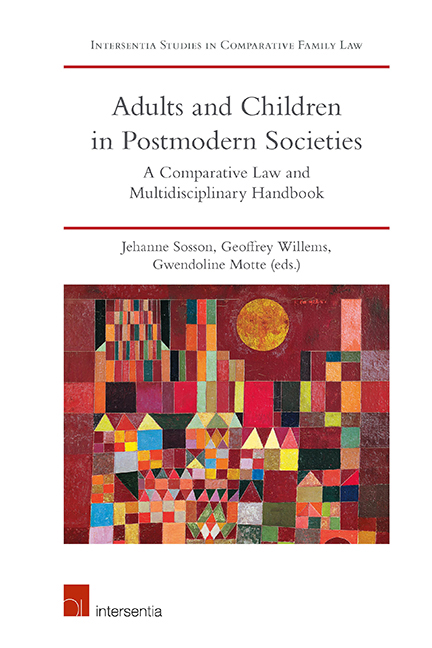Book contents
- Frontmatter
- Contents
- List of Cases
- List of Contributors
- Introduction
- PART I NATIONAL REPORTS ON LEGAL REGULATIONS OF RELATIONSHIPS BETWEEN ADULTS AND CHILDREN
- PART II INTERDISCIPLINARY APPROACH
- Historical Insights: The Historic Evolution of the Place of the Child in His or Her Family: From the Periphery, to the Centre, and Back?
- Philosophical Insights: The Weight of Truth in New Families
- Psychological Insights: Parent–Child Relationships in the Light of Psychology
- PART III INTERNATIONAL LAW INSIGHTS
- PART IV COMPARATIVE APPROACH
- General Conclusion: The Challenge of Transparent and Inclusive Parenthood/Parentality in a Pluralist and Cosmopolitan Context
- About the Editors
Historical Insights: The Historic Evolution of the Place of the Child in His or Her Family: From the Periphery, to the Centre, and Back?
from PART II - INTERDISCIPLINARY APPROACH
Published online by Cambridge University Press: 26 June 2019
- Frontmatter
- Contents
- List of Cases
- List of Contributors
- Introduction
- PART I NATIONAL REPORTS ON LEGAL REGULATIONS OF RELATIONSHIPS BETWEEN ADULTS AND CHILDREN
- PART II INTERDISCIPLINARY APPROACH
- Historical Insights: The Historic Evolution of the Place of the Child in His or Her Family: From the Periphery, to the Centre, and Back?
- Philosophical Insights: The Weight of Truth in New Families
- Psychological Insights: Parent–Child Relationships in the Light of Psychology
- PART III INTERNATIONAL LAW INSIGHTS
- PART IV COMPARATIVE APPROACH
- General Conclusion: The Challenge of Transparent and Inclusive Parenthood/Parentality in a Pluralist and Cosmopolitan Context
- About the Editors
Summary
INTRODUCTION
The place of the child, in the western world and in different parts of the world affected by a certain degree of westernisation, considered from the point of view of the historian, is a particularly vast theme which shall make us travel from Greek and Roman antiquity to our twentieth century.
Approaching this reality in the long run requires the mobilisation of many sources of a particularly diverse nature. In addition to texts of reflection, whether philosophical, pedagogical or psychological, produced in different time periods, alongside private documents expressing intimate concerns, such as correspondence or personal diaries, it is the legal documents, normative or from practice, that provide the essential information. Indeed, they allow the historian to identify the values in force in different time periods and the way they have been implemented and concretised.
Five steps will mark this trip. The first will take us to the side of historians and will try to perceive the way in which knowledge of the history of the family evolves over 30 years. The second will bring us into contact with a general model of the evolution of the place of the child in society and Western culture for 10 centuries. The third and fourth will allow us to grasp two essential turning points: on the one hand, the appearance of a Christian conception of the child, around the third century; and, on the other hand, the establishment of a bourgeois conception of the child, as of the eighteenth century. An analysis of some of the factors that led to the creation of this ‘middle-class’ vision of childhood will be the fifth step in our journey, culminating in the evocation of some questions that currently arise as to this place of the child in our society of the twentieth century.
THE HISTORY OF THE FAMILY
The history of the family does not really begin to interest historians until the 1950s and especially 1960s. Quantitatively, the number of publications literally explodes from the Golden Sixties, mainly in three countries: France, England, and the United States. Qualitatively, the approaches are numerous and diversified, going from the history of law and the economy to that of the demographic evolution, while passing by the history of education or religion.
- Type
- Chapter
- Information
- Adults and Children in Postmodern SocietiesA Comparative Law and Multidisciplinary Handbook, pp. 625 - 640Publisher: IntersentiaPrint publication year: 2019



